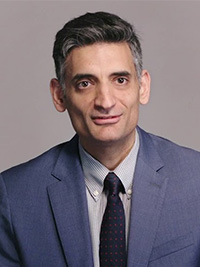Childhood obesity rates are at an all-time high, with the COVID-19 pandemic fueling the latest surge. The rates of obesity among children aged 2 to 19 years rose from 19.3 percent in 2019 to 22.4 percent in 2020, according to a study by the Centers for Disease Control and Prevention that measured obesity in children before and during the pandemic. As the epidemic of obesity increases so does the prevalence of nonalcoholic fatty liver disease (NAFLD), which is being diagnosed at increasingly younger ages. If left undetected and untreated, fatty liver disease can lead to significant liver injury.

Dr. Ali Mencin
For Ali Andre Mencin, MD, Chief of Pediatric Gastroenterology, Hepatology, and Nutrition at NewYork-Presbyterian Morgan Stanley Children’s Hospital and Associate Professor of Pediatrics at Columbia, early detection and treatment of fatty liver diseases are even more important in this patient population. “Nonalcoholic fatty liver disease is associated with the obesity and overweight epidemic,” says Dr. Mencin. “It is really important that physicians have this disease on their radar so that we can identify patients for optimal management early and prevent complications in the future.”
In a review of NAFLD in children published in Gastroenterology, Dr. Dana Goldner, a pediatric gastroenterologist and hepatologist at NewYork-Presbyterian/
With a dedicated multidisciplinary obesity and nonalcoholic fatty liver disease clinical program, NewYork-Presbyterian Morgan Stanley has one of the most experienced teams of pediatric liver specialists, bariatric surgeons, nutritionists, and endocrinologists to care for children with fatty liver disease and obesity-related conditions. “Children who suffer from NAFLD may also have metabolic syndrome, truncal obesity, high blood pressure, and elevated lipids. It is important to manage all of those manifestations of the disease,” says Dr. Mencin, who is also Director of the hospital’s Pediatric Fatty Liver Clinic.
“It is really important that physicians have this disease on their radar so that we can identify patients for optimal management early and prevent complications in the future.” — Dr. Ali Mencin
The multidisciplinary clinic provides specialists who are highly experienced in dietary and lifestyle modifications. In a study by Dr. Mencin, 4.5 percent of children ages 2 to 19 years of age in New York City have NAFLD based on autopsy data, with much higher rates in teenagers and Hispanics of indigenous ancestry. Though the mainstay of treatment remains engaging in a healthy lifestyle with regular exercise and healthy diet to induce weight loss, there have been several clinical trials in children looking at potential medical treatments. NewYork-Presbyterian Morgan Stanley has participated in many of these trials but there are currently no FDA approved medical treatments for pediatric NAFLD. Dr. Mencin believes that glucagon-like peptide-1 (GLP-1) agonists, which were recently approved for the treatment of adolescent obesity, may also be helpful for the treatment of NAFLD, but additional studies are required. Bariatric surgery, which is now performed routinely in adolescents with severe obesity at NewYork-Presbyterian Morgan Stanley, has been shown to be an effective treatment for NAFLD, but remains a last option.
NAFLD can lead to significant liver damage, including liver scarring (fibrosis) and eventually cirrhosis. Up to 30 percent of children with NAFLD have moderate to severe fibrosis and nearly a quarter have prediabetes. In adults, nonalcoholic steatohepatitis (NASH) is a risk factor for hepatocellular carcinoma and is one of the leading indications for liver transplantation. Effective management of NAFLD and comorbidities in the pediatric population could therefore prevent the development of more severe complications in adults.
“The research that we do in pediatric gastroenterology informs our clinical decision-making,” says Dr. Mencin. “At Columbia, we are always heavily involved in research whether it’s basic science or clinical and translational research that has a direct impact on patient care.” Dr. Mencin is hopeful that with a multidisciplinary care model to promote healthy lifestyle along with future medical therapies, pediatric NAFLD can be treated effectively.



